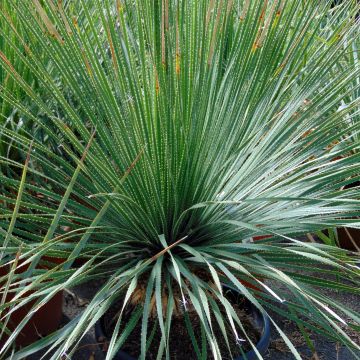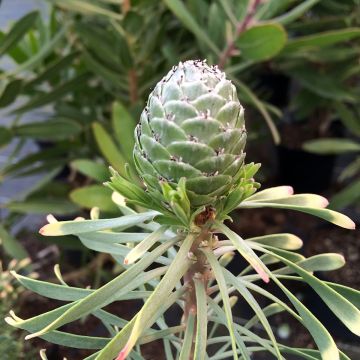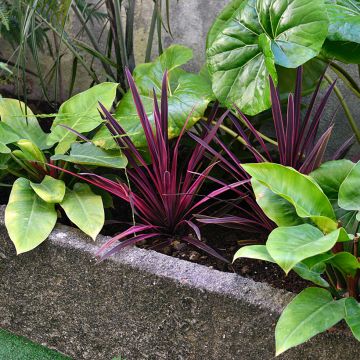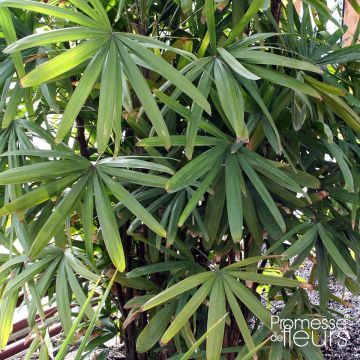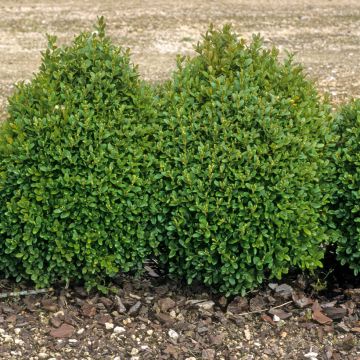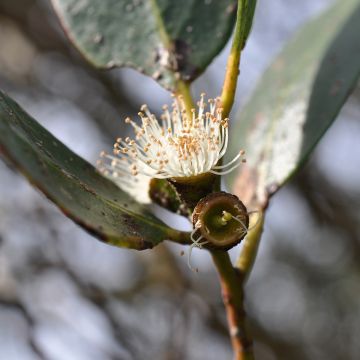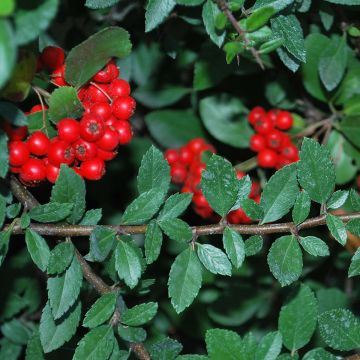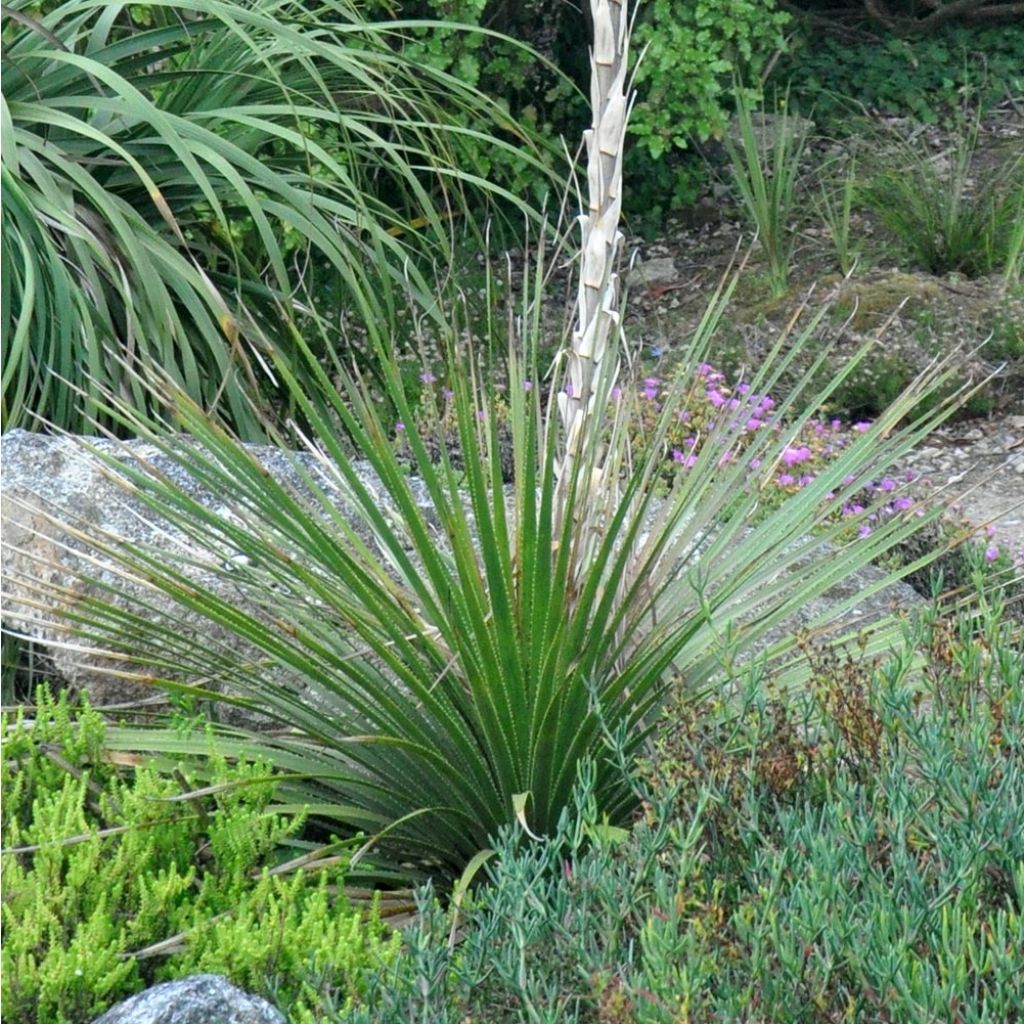

Dasylirion cedrosanum - Dasylire


Dasylirion cedrosanum - Dasylire
Dasylirion cedrosanum - Sotol
Dasylirion cedrosanum
Sotol
This plant carries a 24 months recovery warranty
More information
We guarantee the quality of our plants for a full growing cycle, and will replace at our expense any plant that fails to recover under normal climatic and planting conditions.
From €5.90 for pickup delivery and €6.90 for home delivery
Express home delivery from €8.90.
Does this plant fit my garden?
Set up your Plantfit profile →
Description
The Dasylirion cedrosanum is a very beautiful species of dasylirion, both vigorous and particularly bright. It is a trendy and graphic plant, relatively hardy in well-drained soil, decorative all year round, which requires little care, but makes a sensation in a mineral decor or on a contemporary terrace. This species cedrosanum is characterised by its vigour, and its large, linear and arched leaves, particularly light, ranging from bluish glaucous to white-glaucous, with spiny margins. This plant, resembling a large sea urchin planted on a short trunk, blooms after many years, in the form of a tall flowering stem adorned with small yellow to cream flowers. Dasylirion can be grown in the ground as well as in a pot. It is an excellent rockery or dry garden plant to grow in poor, rocky or sandy soil.
Originally from the Mexican highlands of the Sierra Madre Occidental and the Sierra Madre Oriental in Mexico, the Dasylirion cedrosanum is capable of withstanding temperatures around -12/-15°C (10.4/5 °F) in well-drained soils, if it is somewhat sheltered from rain, and it tolerates long periods of summer drought. In nature, it is usually found on rocky slopes in limestone soil.
It is a rhizomatous plant belonging to the Agave family, slow-growing in dry soil, faster in moist soil. When young, the dasylirion forms a dense, shaggy ball. After many years, it can form a partially underground trunk about 1m (3 ft 4 in) tall, sometimes branching, covered with remnants of old leaves, brownish in colour, forming a kind of skirt. They can be cut to highlight the trunk. This trunk often ends up lying down, without stopping growing. It bears a spherical crown 1m (3 ft 4 in) to 1.30m (4 ft 4 in) wide, composed of several hundred succulent, radiating, linear leaves, 2.5 cm (1 in) wide, gutter-shaped, bordered by yellowish to brownish spines. The leaves are slightly twisted on their axis. Flowering occurs after 10 to 15 years of cultivation, in summer. A slender, upright floral stem emerges from the centre of the rosette at 2m (6 ft 7 in), among the leaves. The very small flowers, ranging from cream to pale yellow, are tightly packed along thin branches that emanate from the floral stem which remain on the plant, often until winter. Male plants are distinct from female plants. When watered during the summer, this dasylirion shows spectacular growth. Careful consideration should be given to the location of this plant, and it should not be disturbed: its fragile root system does not like to be disturbed and does not tolerate transplantation very well. Unlike the agave, the dasylirion is not a monocarpic plant: flowering does not result in the death of the rosette, a lateral bud located on the main axis of the plant will take over.
The Dasylirion cedrosanum is a bright, architectural plant that charms with the graceful symmetry of its vegetation. Superb in a large pot with simple shapes, it is perfect in a minimalist garden. Give it plenty of sunlight and soil that does not retain water, as it does not tolerate heavy and wet soils in winter. It is perfect on a large arid slope, at the top of a large exotic or contemporary rockery, or even near a swimming pool if the soil is well prepared to accommodate it. To dress its base, consider, for example, a carpet of silver basket, Cerastostigma plumbaginoides, Delosperma, or a dry meadow called Zoyzia tenuifolia, the Mascarene grass. It can also be planted with agaves, prickly pears, relatively hardy candelabra cacti (Cleistocactus strausii, Cylindropuntia imbricata), and equally spectacular and frugal shrubby aloes.
Report an error about the product description
Dasylirion cedrosanum - Sotol in pictures






Plant habit
Flowering
Foliage
Botanical data
Dasylirion
cedrosanum
Agavaceae (Asparagaceae)
Sotol
North America
Other Dasylirion
Planting and care
It is best to plant a Dasylirion cedrosanum in the spring when the location is sunny and sheltered. This is especially important if your garden is in a borderline hardiness zone. A well-established plant can withstand brief frosts of around -12/-15°C (10.4/5°F) as long as the soil is perfectly drained, even if it's very dry, stony, rocky or sandy. Young plants need protection from winter rain, especially at the root and base, as they are more fragile.
The plant grows slowly, but you can speed up growth by growing generously but spaced out in the summer and ensuring the soil is fertile. In mild climates, plant in the autumn, especially if the summers are hot and dry. Transplantation requires careful precautions: remove the root ball without damaging it, being careful with the roots.
Dasylirion cedrosanum fears heavy and humid soils, especially when combined with cold. Ideally, place the plant in a large rockery, on a slope, on a raised bed whose soil has been enriched with gravel, or on a rocky embankment. The plant tolerates poor soil but grows slightly faster in somewhat fertile soil. Monitoring watering during the first two years is vital, especially in hot and dry periods. Remember to remove faded stems.
If your dasylirion is not flowering, it is probably too young or has only been planted in your garden for 3 or 4 years. This plant takes time to establish itself and only flowers after 10 to 15 years, mainly in warmer areas. Depending on the sunlight and climate, it will flower every year or two or three years. If the plant benefits from automated drip irrigation in summer, its growth will be boosted and 5-year-old rosettes will be able to flower.
Multiplication:
Sowing in the spring can be a challenging task and is best done by professionals!
Planting period
Intended location
Care
This item has not been reviewed yet - be the first to leave a review about it.
Evergreen shrubs
Haven't found what you were looking for?
Hardiness is the lowest winter temperature a plant can endure without suffering serious damage or even dying. However, hardiness is affected by location (a sheltered area, such as a patio), protection (winter cover) and soil type (hardiness is improved by well-drained soil).

Photo Sharing Terms & Conditions
In order to encourage gardeners to interact and share their experiences, Promesse de fleurs offers various media enabling content to be uploaded onto its Site - in particular via the ‘Photo sharing’ module.
The User agrees to refrain from:
- Posting any content that is illegal, prejudicial, insulting, racist, inciteful to hatred, revisionist, contrary to public decency, that infringes on privacy or on the privacy rights of third parties, in particular the publicity rights of persons and goods, intellectual property rights, or the right to privacy.
- Submitting content on behalf of a third party;
- Impersonate the identity of a third party and/or publish any personal information about a third party;
In general, the User undertakes to refrain from any unethical behaviour.
All Content (in particular text, comments, files, images, photos, videos, creative works, etc.), which may be subject to property or intellectual property rights, image or other private rights, shall remain the property of the User, subject to the limited rights granted by the terms of the licence granted by Promesse de fleurs as stated below. Users are at liberty to publish or not to publish such Content on the Site, notably via the ‘Photo Sharing’ facility, and accept that this Content shall be made public and freely accessible, notably on the Internet.
Users further acknowledge, undertake to have ,and guarantee that they hold all necessary rights and permissions to publish such material on the Site, in particular with regard to the legislation in force pertaining to any privacy, property, intellectual property, image, or contractual rights, or rights of any other nature. By publishing such Content on the Site, Users acknowledge accepting full liability as publishers of the Content within the meaning of the law, and grant Promesse de fleurs, free of charge, an inclusive, worldwide licence for the said Content for the entire duration of its publication, including all reproduction, representation, up/downloading, displaying, performing, transmission, and storage rights.
Users also grant permission for their name to be linked to the Content and accept that this link may not always be made available.
By engaging in posting material, Users consent to their Content becoming automatically accessible on the Internet, in particular on other sites and/or blogs and/or web pages of the Promesse de fleurs site, including in particular social pages and the Promesse de fleurs catalogue.
Users may secure the removal of entrusted content free of charge by issuing a simple request via our contact form.
The flowering period indicated on our website applies to countries and regions located in USDA zone 8 (France, the United Kingdom, Ireland, the Netherlands, etc.)
It will vary according to where you live:
- In zones 9 to 10 (Italy, Spain, Greece, etc.), flowering will occur about 2 to 4 weeks earlier.
- In zones 6 to 7 (Germany, Poland, Slovenia, and lower mountainous regions), flowering will be delayed by 2 to 3 weeks.
- In zone 5 (Central Europe, Scandinavia), blooming will be delayed by 3 to 5 weeks.
In temperate climates, pruning of spring-flowering shrubs (forsythia, spireas, etc.) should be done just after flowering.
Pruning of summer-flowering shrubs (Indian Lilac, Perovskia, etc.) can be done in winter or spring.
In cold regions as well as with frost-sensitive plants, avoid pruning too early when severe frosts may still occur.
The planting period indicated on our website applies to countries and regions located in USDA zone 8 (France, United Kingdom, Ireland, Netherlands).
It will vary according to where you live:
- In Mediterranean zones (Marseille, Madrid, Milan, etc.), autumn and winter are the best planting periods.
- In continental zones (Strasbourg, Munich, Vienna, etc.), delay planting by 2 to 3 weeks in spring and bring it forward by 2 to 4 weeks in autumn.
- In mountainous regions (the Alps, Pyrenees, Carpathians, etc.), it is best to plant in late spring (May-June) or late summer (August-September).
The harvesting period indicated on our website applies to countries and regions in USDA zone 8 (France, England, Ireland, the Netherlands).
In colder areas (Scandinavia, Poland, Austria...) fruit and vegetable harvests are likely to be delayed by 3-4 weeks.
In warmer areas (Italy, Spain, Greece, etc.), harvesting will probably take place earlier, depending on weather conditions.
The sowing periods indicated on our website apply to countries and regions within USDA Zone 8 (France, UK, Ireland, Netherlands).
In colder areas (Scandinavia, Poland, Austria...), delay any outdoor sowing by 3-4 weeks, or sow under glass.
In warmer climes (Italy, Spain, Greece, etc.), bring outdoor sowing forward by a few weeks.


































